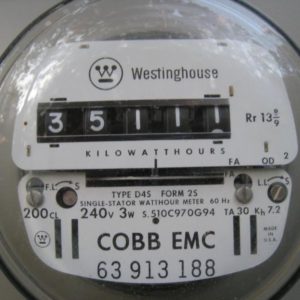Hello,
I would like to upgrade the main electrical panel in my home from a 150 amp panel to a 200 amp panel. I have been told that it is likely that I have a 150 amp meter and would have to upgrade it with the panel, which would mean involving the power company as well as spending a bunch more money. If I already have a 200 amp meter, then of course, the whole thing will cost a good bit less.
I have attached a photo of my meter in the hopes that someone can positively identify it for me. As you will see the meter has a big “200” printed on the front of it, but I don’t want to assume that means 200 amp.
Thanks in advance.
JAH




















Replies
That is a 200 amp meter, that is the 200CL designation.
But that does not mean that the POCO drop is rated for 200 amps.
And, BTW, the POCO uses their own rules for sizing so really can't tell by looking at the size.
William the Geezer, the sequel to Billy the Kid - Shoe
If I already have a 200 amp meter, then of course, the whole thing will cost a good bit less.
Why would it cost more? The utility should supply the meter, so there is no cost to you. The utility will need to be involved in any event, unless the work is done by a licensed electrician who is approved by the utility to do this type of work.
I can't help with the meter.
I would check with the local power company. Around here they provide the meter, so if we upgrade service they will give us the new meter can for free. The electricians then install it, usually into the same meter box.
Wow, that was fast. Thanks very much for the help.I was told by an electrician that the power co. would not upgrade the meter and bring things up to current code for free. I will take the advice given here and call the power co. directly. Installing a main panel is a step or two past my comfort zone so I will be having a licensed electrician do the install. I will ask the power co. if there are any that they certify to do the whole thing, or if they will have to be involved. Thanks again.Jesse
it is a WESTINGHOUSE meter <G>
I was told by an electrician that the power co. would not upgrade the meter and bring things up to current code for free.
It does vary with the power company, but assuming you have overhead power lines, usually the homeowner is responsible for the weatherhead down. So the HO provides the meter socket, service entrance cable, etc. but the utility provides the meter itself and also makes the connection to their feeder line.
So the electrician is correct that the utility will not do the upgrade, however they will likely provide the meter. Your electrician probably was just not clear on that part or didn't want to confuse the issue.
However, some electricians will be approved by the utility to make the connection, so the power company MAY not have to come out. In my experience, all utilities want the new install to be inspected by an inspector they have approved before it is connected to their line.
http://www.inspect-ny.com/electric/ElectricMeters.htm
"The meter itself is also a consideration when determining the service ampacity of an electrical system. Most modern meters for single family homes have the designation "CL200" somewhere on their face, which indicates they are rated for up to a 200 Amp service."
You also have to look at the size of the service conductors on the utility's side of the meter to make sure they are large enough, as well as the conduit (assuming there is one.) Finally, the utility will have to review their transformer out on the pole to make sure they have the capacity for an upgrade.
Edited 11/5/2009 8:00 pm by Stuart
You also have to look at the size of the service conductors on the utility's side of the meter to make sure they are large enough, as well as the conduit (assuming there is one.) Finally, the utility will have to review their transformer out on the pole to make sure they have the capacity for an upgrade.
The utility will do that - and will generally use the same equipment for 100A through 200A service. Their conductors are in free air, so they are not derated as much as cable.
Another consideration is how the cable will attach to the building. Any more, the utilities seem to want a through bolt insulator, while a lag screw insulator and a rawl plug used to be acceptable. If so, you will have to cut into the interior wall to install the through bolt, unless you can do it in the attic or other unfinished space.
I went from 100 to 200 and they left the 2ga triplex drop. They said that is what everyone gets. They even had the crimp sleeve to go from my 4/0al down to the #2. The PoCo follows different rules.